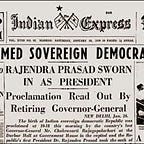The National Identity XIII: “Tawang Must Not Fall”
India’s China strategy and its’ non-evolution
In 1962 the Indian Army was at its lowest ebb in over 200 years. The Indian Army acquitted itself reasonably well in the Western Ladakh sector; but its’ performance on the Eastern front (in Arunachal and Sikkim) was abysmal. While there were certainly accentuating factors, including political, the Indian Army had to pull itself by its’ bootstraps and wrench itself into countering the new paradigm of foes on the Eastern, Western and Northern fronts. The Army (and the MoD) responded by raising six new divisions — four infantry divisions and two mountain divisions, and setting up the Officers Training Academy in Madras.
— — — — — — — — — — — — — — — — — — — — — — — — — — — — — — —
General KV Krishna Rao was confident that his operational plan for countering possible Chinese aggression in the North East would be met with a positive response from the Prime Minister’s Office. The year was 1983 and Indira Gandhi had just been voted back in, and with the scars of the Emergency still raw, she was eager to focus on foreign, rather than domestic, enemies. This was a strategy which her son Prime Minister Rajiv Gandhi largely continued. For more than twenty years, India had not entered the theater of its’ most humiliating defeat. The Army top…
